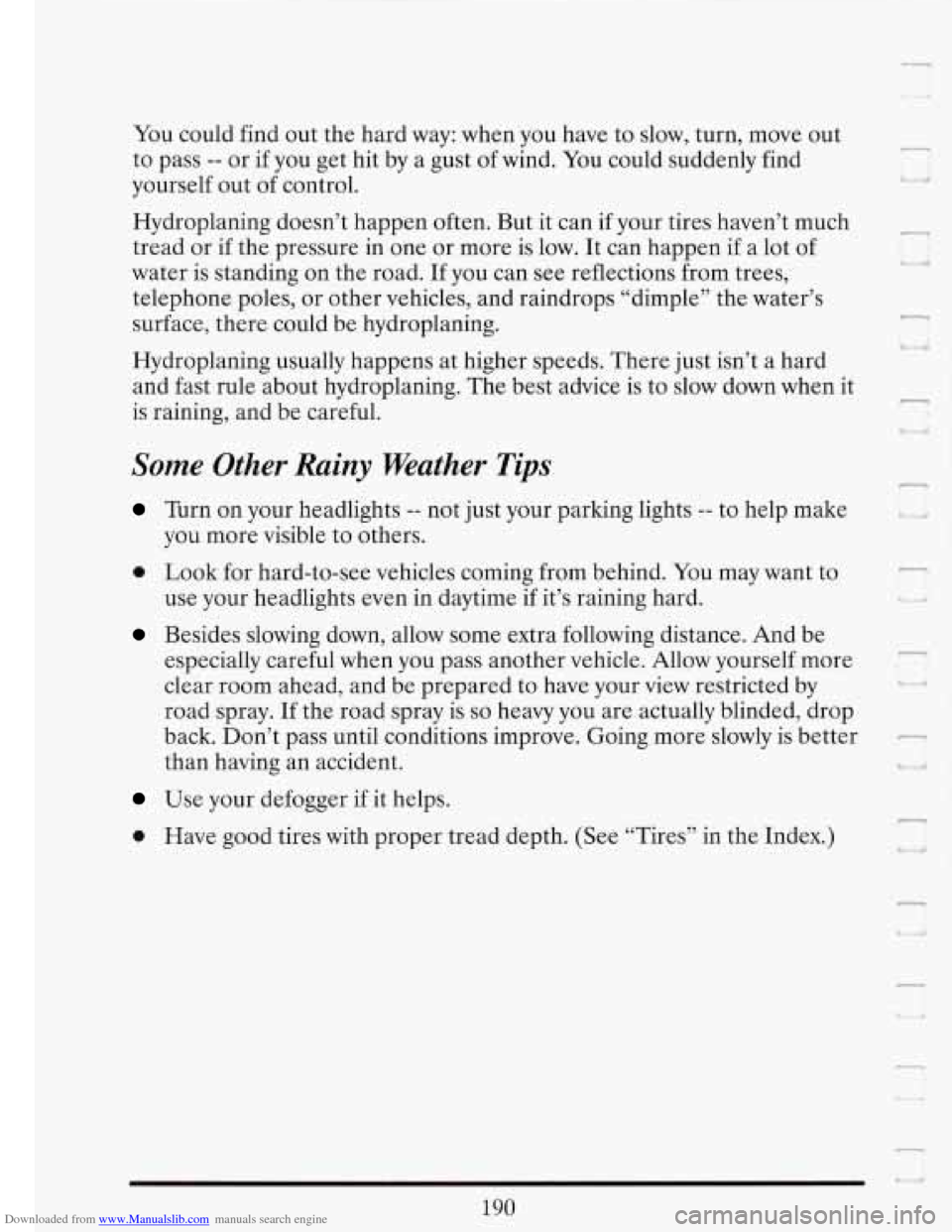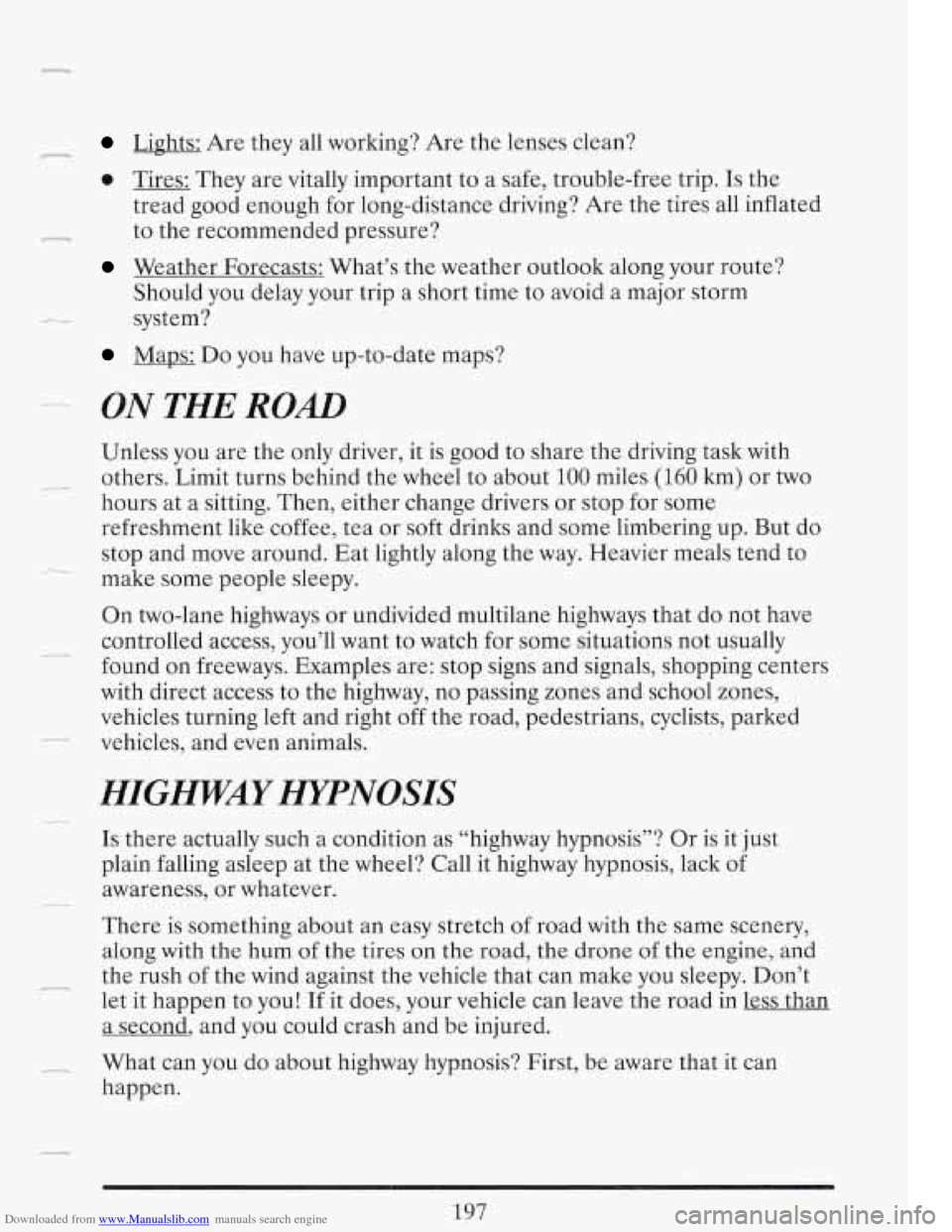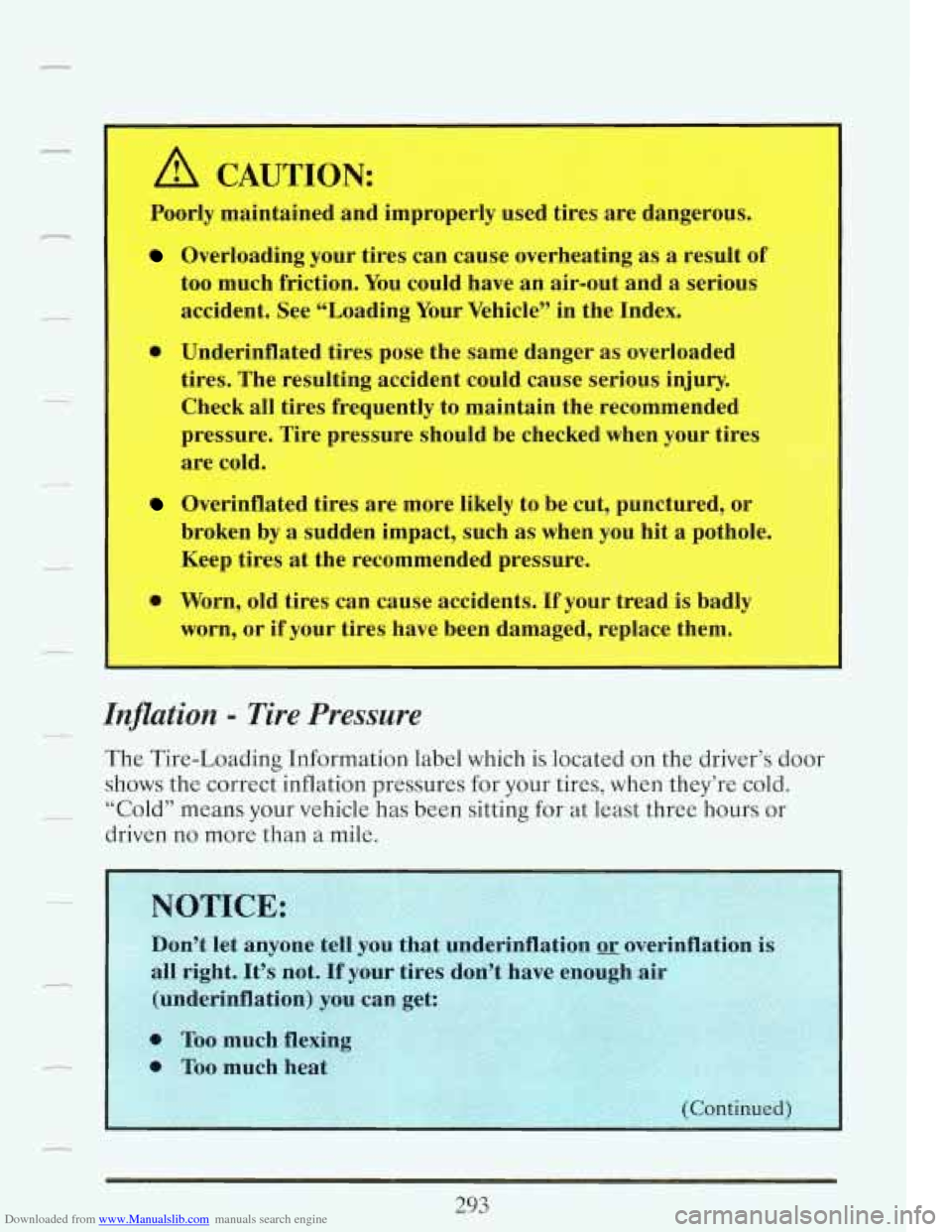Page 188 of 386
Downloaded from www.Manualslib.com manuals search engine Here’s how anti-lock works. Let’s say the road is wet. You’re driving
safely. Suddenly an animal jumps out in front
of you.
You slam on the brakes. Here’s what happens with
ABS.
A computer senses that wheels are slowing down. The computer
separately works the brakes at each front wheel and at the rear wheels.
c
U
The anti-lock system can change the brake pressure faster than any driver 7 could. The computer
and road conditions. is programmed to make the most of available tire u
n
You can steer around the obstacle while braking hard. .-
L.4
Page 204 of 386

Downloaded from www.Manualslib.com manuals search engine You could find out the hard way: when you have to slow, turn, move out
to pass
-- or if you get hit by a gust of wind. You could suddenly find
yourself out of control.
Hydroplaning doesn’t happen often. But it can if your tires haven’t much
tread or if the pressure in one or more is low. It can happen if a lot of
water is standing on the road.
If you can see reflections from trees,
telephone poles, or other vehicles, and raindrops “dimple” the water’s
surface, there could be hydroplaning.
Hydroplaning usually. happens at higher speeds. There just isn’t a hard
and fast rule about hydroplaning. The best advice is to slow down when it
is raining, and be careful.
Some Other Rainy Weather Tips
Turn on your headlights -- not just your parlung lights -- to help make
you more visible to others.
0 Look for hard-to-see vehicles coming from behind. You may want to
use your headlights even in daytime if it’s raining hard.
Besides slowing down, allow some extra following distance. And be
especially careful when you pass another vehicle. Allow yourself more
clear room ahead, and be prepared to have your view restricted by
road spray.
If the road spray is so heavy you are actually blinded, drop
back. Don’t pass until conditions improve. Going more slowly is better
-
than having an accident. I
L1
I
Use your defogger if it helps.
0 Have good tires with proper tread depth. (See “Tires” in the Index.)
-
Y
190 I
Page 211 of 386

Downloaded from www.Manualslib.com manuals search engine - Lights: Are they all working? Are the lenses clean?
0 Tires: They are vitally important to a safe, trouble-free trip. Is the
tread good enough for long-distance driving? Are the tires all inflated
to the recommended pressure?
Weather Forecasts: What’s the weather outlook along your route?
Should you delay your trip a short time to avoid a major storm
system?
Maps: Do you have up-to-date maps?
_- - ON THE ROAD
Unless you are the only driver, it is good to share the driving task with
hours at a sitting. Then, either change drivers or stop for some
refreshment like coffee, tea or soft drinks and some limbering up. But do
stop and move around. Eat lightly along the way. Heavier meals tend
to
make some people sleepy.
- others. Limit turns behind the wheel to about 100 miles (160 km) or two
- ._
On two-lane highways or undivided multilane highways that do not have
controlled access, you’ll want to watch for some situations not usually
found on freeways. Examples are: stop signs and signals, shopping centers
with direct access to the highway,
no passing zones and school zones,
vehicles turning left and right off the road, pedestrians, cyclists, parked
vehicles, and even animals.
-
-
HIGWAY HYPNOSIS
c_
Is there actually such a condition as “highway hypnosis”? Or is it just
plain falling asleep at the wheel? Call it highway hypnosis, lack
of
awareness, or whatever.
There is something about an easy stretch of road with the same scenery,
along with the hum
of the tires on the road, the drone of the engine, and
- the rush of the wind against the vehicle that can make you sleepy. Don’t
let it happen
to you! If it does, your vehicle can leave the road in less than
a second, and you could crash and be injured.
happen.
__
- What can you do about highway hypnosis? First, be aware that it can
Page 217 of 386
Downloaded from www.Manualslib.com manuals search engine r
If “torque lock” does occur, you may need to have another vehicle push
yours a little uphill to take some
of the pressure from the transmission, so
you can pull the shift lever out of “P” (Park).
WINTER DRWTNG
Here are some tips for winter driving:
Have your Cadillac in good shape for winter. Be sure your engine
Snow tires can help in loose snow, but they may give you less traction
on ice than regular tires. If you do not expect to be driving in deep
snow, but may have to travel over ice, you may not want to switch to
snow tires at all.
coolant
mix is correct.
You may want to put winter emergency supplies in your trunk.
203
Page 251 of 386

Downloaded from www.Manualslib.com manuals search engine 8. Then replace the
pressure cap. Be
sure the arrows on
the pressure cap
line up like this.
IF A TIRE GOES FLAT
-- It’s unusual for a tire to “blow out” while you’re driving, especially if you
maintain your tires properly. If air goes out of a tire, it’s much more likely
to leak out slowly. But
if you should ever have a “blowout,” here are a
If a front tire fails, the flat tire will create a drag that pulls the vehicle
toward that side. Take your foot
off the accelerator pedal and grip the
to a stop well out of the traffic lane.
A rear blowout, particularly on a curve, acts much like a skid and may
remove your foot from the accelerator pedal. Get the vehicle under
control by steering the way you want the vehicle to go. It may be
very
the road if possible.
__ few tips about what to expect and what to do:
__ steering wheel firmly. Steer to maintain lane position, then gently brake
__ require the same correction you’d use in a skid. In any rear blowout,
__ bumpy and noisy, but you can still steer. Gently brake to a stop, well off
If your tire goes flat, the next section shows how to use your jacking
--- equipment to change a flat tire safely.
CHMGING A FLAT TIRE
._- If a tire goes flat, avoid further tire and wheel damage by driving slowly to
a
level place. Turn on your hazard warning flashers.
237
Page 262 of 386
Downloaded from www.Manualslib.com manuals search engine Align the upper
locator pins and insert
-
the pins into the holes. .
n
Push the handles up to lock the skirt in place.
COMPACT SPARE TIRE
Although the compact spare was fully inflated when your vehicle was
new, it can lose air after a time. Check the inflation pressure regularly. It
should be
60 psi (420 kPa). The compact spare is made to go up to 3,000 -
miles (5000 km), so you can finish your trip and have your full-size tire i* u
repaired or replaced where you want. Of course, it’s best to replace your I
spare with a full-size tire as soon as you can. Your spare will last longer
and be in good shape in case you need it again.
Your anti-lock brake system warning light may come on when
you are
driving with a compact spare. See “Anti-Lock Brake System Warning
Light” in the Index.
Don’t use your compact spare on some other vehicle.
248
Page 304 of 386
Downloaded from www.Manualslib.com manuals search engine I
3. Reinstall the new
insert by aligning
the blade housing
tabs and the edge
of the insert. Make
sure that the insert
is connected to all
the housing tabs.
4. Install the wiper blade assembly to the wiper arm.
LOmING YOUR VEHICLE
OCCUPANTS VEHICLE CAP.
WT.
TIRE-LOADING INFORMATION
FRT. CTR.
RR. TOTAL LBS. KG
MAX. LOADING & GVWR SAME AS VEHICLE
CAPACITY WEIGHT XXX COLD TIRE
TIRE
SIZE SPEED PRESSURE RTG
PSVKPa
FRT.
R R.
SPA.
IF TIRES ARE HOT. ADD 4PSV28KPa SEE
OWNER’S MANUAL FOR ADDITIONAL
INFORMATION
GEN GME
Two labels on your vehicle show how much weight it may properly carry.
The Tire-Loading Information label found on the driver’s door tells you
the proper size, speed rating and recommended inflation pressures for
n
290
Page 307 of 386

Downloaded from www.Manualslib.com manuals search engine A CAUTION:
i --
Poorly maintained and improperly used tires are dangerous.
Overloading your tires can cause overheating as a result of
I
too much friction. You could have an air-out and a serious
accident. See “”Loading Your Vehicle” in the Index.
0 Underinflated tires pose the same danger as overloaded
tires. The resulting accident could cause serious injury.
Check all tires frequently
to maintain the recommended
pressure. Tire pressure should
be checked when your tires
are cold.
I
I Overinflated tires are more likely to be cut, punctured, or
broken by
a sudden impact, such as when you hit a pothole.
Keep tires at the recornmended pressure.
@ Worn, old tires can cause accidents. If your tread is badly
worn, or if your tires have been damaged, replace them.
Inflation - Tire Pressure _c
The Tire-Loading Information label which is located on the driver’s door
shows the correct inflation pressures
for your tires, when they’re cold.
driven no more than a mile.
- “Cold’’ means your vehicle has been sitting for at least three hours or
293